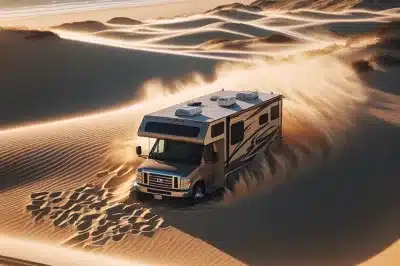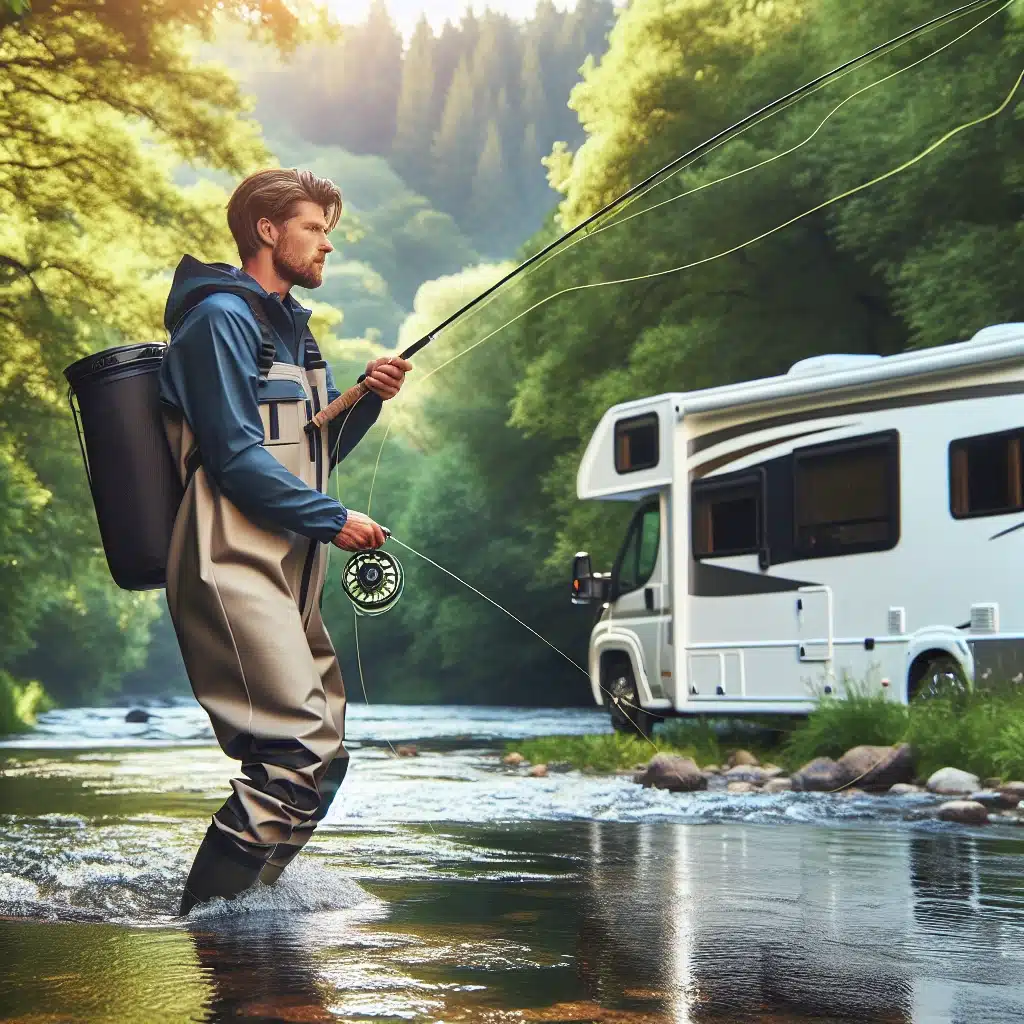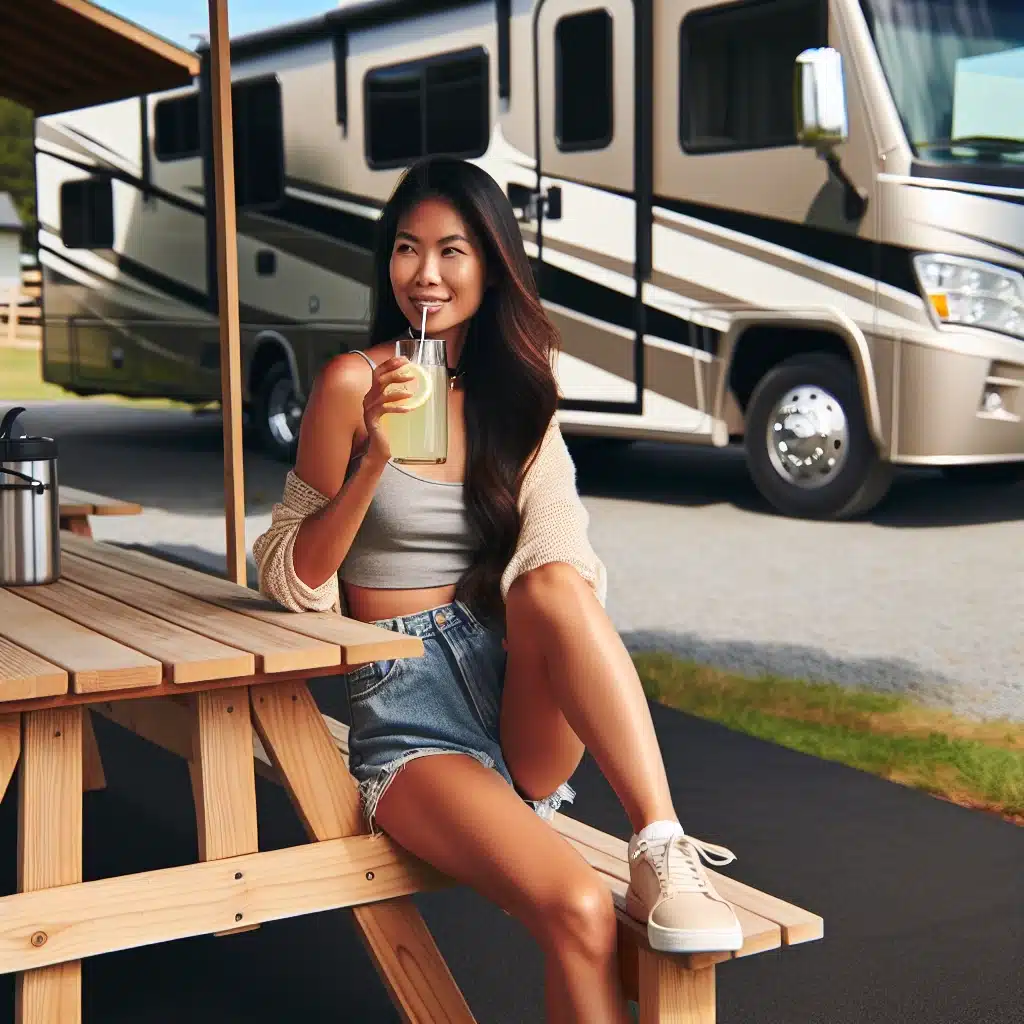Table of Contents

Boondocking Mastery: Your Solar Power System Guide
Imagine the freedom of exploring the great outdoors with all the comforts of home at your fingertips. That’s the promise of boondocking with a solar-powered motorhome. In this guide, I’ll walk you through the ins and outs of sizing and selecting the perfect solar power system for your home on wheels. From understanding your energy needs to choosing the right components, we’ll cover everything you need to live off the grid in style and sustainability.
Why Solar? Unleashing Motorhome Freedom
Why go solar? It’s all about independence. With a solar power system, you’re not tethered to campground hookups or generator fuel. You can park where you want and stay as long as you like. Plus, solar energy is clean, quiet, and, once installed, free to harness. It’s a game-changer for the boondocking lifestyle, allowing you to enjoy the wilderness without leaving a trace.
- Endless energy from the sun for off-grid adventures.
- No more reliance on noisy, costly generators.
- Reduce your carbon footprint with clean, renewable power.
- Freedom to travel without searching for hookups.
- Increased self-sufficiency and peace of mind.
Solar Basics for the Road
Before we dive into the details, let’s cover some solar power basics. A solar power system for your motorhome includes solar panels, a battery bank, a charge controller, and an inverter. The panels collect sunlight and convert it into electricity. The charge controller regulates this power to charge your batteries safely. The battery bank stores this energy for use anytime, and the inverter turns the stored DC power into AC power for your appliances.
It’s a straightforward concept, but the devil is in the details. The right system for you depends on your specific energy needs, travel habits, and the size of your motorhome. Let’s start by figuring out how much power you’ll need.
Decoding Solar Power Needs
Understanding your power needs is crucial for a well-functioning solar setup. Underestimating can leave you in the dark, while overestimating can lead to unnecessary expenses. It’s all about balance.
Calculating Your Motorhome’s Energy Appetite
First, calculate your daily power usage. List all the electronics and appliances you use and note their wattage. Multiply the wattage by the number of hours you use each item daily to get the total watt-hours. Add them up, and you’ve got a rough estimate of your daily consumption. Remember, it’s better to overestimate a bit to avoid power shortages.
For example, if you use a 100-watt light for 5 hours, that’s 500 watt-hours. Do this for all your devices, and you’ll have a comprehensive view of your energy needs. This total is your target for daily solar power generation.
Tools & Tips for Measuring Consumption
While estimating is a good start, precision matters. Use a power meter to measure the actual consumption of your devices. These handy tools can give you real-time data on how much power you’re using, which is invaluable for fine-tuning your solar setup.
Also, consider investing in energy-efficient appliances and LED lighting to reduce your overall consumption. The less power you use, the smaller and more cost-effective your solar system can be. Remember, every watt counts when you’re boondocking.
- Make a list of all electrical devices and their wattage.
- Use a power meter for accurate consumption data.
- Invest in energy-efficient appliances to lower energy needs.
- Consider your lifestyle and adjust for peak usage times.
- Keep a buffer in your calculations for unexpected usage.

Choosing the Right Solar Setup
With your power needs in hand, it’s time to choose a solar setup that fits your motorhome and lifestyle. The right system balances capacity, efficiency, and budget. You’ll want enough power to meet your needs, with a little extra for cloudy days or unexpected power usage. It’s not just about getting the biggest setup; it’s about getting the smartest one for you.
Motorhome Classes and Solar Compatibility
Motorhomes come in different classes—Class A, B, and C—and each has its own space and weight considerations for solar panels. Class A, the largest, offers plenty of roof space for solar panels, while Class B and C might require more creative solutions due to limited space. No matter the class, there’s a solar solution that fits. It’s about matching the system to your vehicle’s capabilities and your energy demands.
- Class A motorhomes can accommodate larger solar arrays.
- Class B and C may need compact or portable solar solutions.
- Consider the weight of solar components relative to your RV’s capacity.
- Factor in your travel habits; more travel may necessitate a sturdier setup.
The Essential Components of a Solar Power System
Every solar power system includes four essential components: solar panels, a charge controller, a battery bank, and an inverter. Solar panels capture sunlight; the charge controller manages the power flow to the batteries; the battery bank stores energy for later use; and the inverter converts DC power from the batteries to AC power for your appliances. Selecting quality components ensures reliability and efficiency on the road.
- Solar Panels: The face of your solar system, capturing the sun’s rays.
- Charge Controller: The gatekeeper, ensuring your batteries charge safely.
- Battery Bank: Your energy reservoir for when the sun isn’t shining.
- Inverter: The translator, turning DC power into usable AC power.
Panel Placement: Rooftop vs. Portable Options
Where you place your solar panels can make a big difference. Rooftop panels are a popular choice for their convenience and security. They’re always there, collecting power as you drive or park. Portable panels, on the other hand, offer flexibility. You can move them around to catch the most sun, and they’re ideal if your roof space is limited or you want to park in the shade.
- Rooftop panels are great for convenience and efficiency.
- Portable panels provide flexibility and are easy to store.
- Consider combining both for maximum solar collection.
- Remember to factor in the aerodynamics and weight distribution of your RV.
Customizing Your Solar Solutions
Customization is key to getting the most out of your solar power system. By tailoring your setup to your specific needs, you ensure you’re never without power when you need it. This might mean adding extra panels for increased capacity or selecting a larger battery bank to store more energy. Let’s explore how to customize your system effectively.
Battery Bank Sizing: Power Through the Night
The size of your battery bank determines how long you can run your appliances without sunlight. To size your battery bank, consider the total watt-hours you use daily and how many days of autonomy you want. A good rule of thumb is to have enough capacity to cover your energy usage for at least a couple of days, ensuring you have power through cloudy weather or increased usage.
- Calculate your daily watt-hour usage to determine battery capacity.
- Consider how many days of autonomy you want as a safety net.
- Choose deep-cycle batteries designed for regular charging and discharging.
- Remember, more batteries mean more weight and space used in your RV.
- Ensure your battery bank is accessible for maintenance and ventilation.
Power Inverters: Understanding Capacity and Efficiency
Power inverters are the unsung heroes of your solar power system. They take the DC electricity stored in your batteries and convert it into AC power that your everyday appliances can use. But not all inverters are created equal. You’ll want one that matches your system’s voltage and has enough capacity to handle your peak power demands. Plus, look for an inverter with high efficiency to get the most out of your stored energy.
- Match the inverter to your system’s voltage for compatibility.
- Ensure it can handle your highest power usage at any one time.
- High-efficiency models convert more of your battery power into usable electricity.
- Consider inverters with additional features like power saving modes or built-in chargers.
Charge Controllers: Protecting Your Investment
Your charge controller is the guardian of your battery bank, managing the flow of electricity and preventing overcharging. A good charge controller extends the life of your batteries and improves the overall efficiency of your solar system. There are two main types: PWM (Pulse Width Modulation) and MPPT (Maximum Power Point Tracking). MPPT controllers are more efficient, especially in variable weather conditions, making them worth the investment for serious boondockers.
- PWM controllers are more cost-effective but less efficient.
- MPPT controllers optimize power transfer, making them ideal for fluctuating conditions.
- Choose a charge controller with a higher current rating than your solar array’s output.
- Look for controllers with additional features like load control and battery temperature sensors.

Installation and Maintenance: Doing it Right
Proper installation and maintenance are crucial to getting the most out of your solar power system. A well-installed system will operate efficiently and safely, while regular maintenance will keep it running smoothly for years to come. Let’s break down what you need to know to keep your system in top shape.
DIY vs. Professional Installation: Making the Choice
Installing a solar power system can be a rewarding DIY project, but it’s not for everyone. If you’re comfortable with basic electrical concepts and handy with tools, you might enjoy the challenge. However, if you’re unsure, there’s no shame in calling in the pros. Professional installation ensures your system is set up correctly and safely, and it often comes with additional warranties and support.
- DIY installation can save money but requires technical knowledge and skills.
- Professional installation offers peace of mind and expertise.
- Consider the complexity of your system when deciding between DIY and professional installation.
- Check if professional installation is required to maintain warranty coverage.
Routine Maintenance: Keeping the Current Flowing
Like any part of your motorhome, your solar power system needs regular maintenance to perform its best. Keep your solar panels clean and free of debris to ensure maximum sunlight absorption. Check your battery water levels if you’re using lead-acid batteries, and ensure all connections are tight and corrosion-free. Regularly inspect your system for any signs of wear and tear, and address issues promptly to avoid bigger problems down the road.
- Clean solar panels regularly to maintain efficiency.
- Monitor and maintain battery water levels if applicable.
- Inspect connections and wiring for signs of damage or corrosion.
- Keep an eye on your charge controller and inverter for any error messages or alerts.
- Schedule an annual professional inspection to catch any issues you may have missed.
Advanced Tips and Tricks
Now that you’ve got the basics down, let’s look at some advanced tips and tricks to optimize your solar power system. These are the little tweaks and upgrades that can make a big difference in your boondocking experience. Whether it’s aligning your panels for maximum sun exposure or adding a monitoring system to keep track of your energy, these tips will help you get the most out of your solar setup.
Remember, solar power is an investment in your freedom and sustainability. With the right system, maintenance, and a few advanced strategies, you can enjoy the boondocking lifestyle to its fullest. Stay tuned for more detailed insights in each of these areas to ensure your adventures are always powered by the sun.
Maximizing Sun Exposure: Aligning Panels Properly
Getting the most out of your solar panels means placing them where they’ll receive the maximum amount of sunlight. The angle and direction of your panels can significantly impact their efficiency. In general, you want to aim them true south in the Northern Hemisphere and true north in the Southern Hemisphere. Adjust the tilt angle based on the season—steeper in winter when the sun is lower and flatter in summer when it’s higher. Portable panels give you the advantage of adjusting your setup throughout the day to follow the sun’s path.
- Aim panels true south (in the Northern Hemisphere) for optimal sun exposure.
- Adjust the tilt of your panels seasonally for maximum efficiency.
- Consider using a solar tracker for automatic alignment (though this is an advanced option).
- For portable panels, reposition them a few times a day to follow the sun.
- Ensure no shadows fall on the panels throughout the day for uninterrupted power.
Monitoring Systems: Keeping an Eye on Your Energy
Knowledge is power, and this is especially true for managing your solar power system. A monitoring system gives you real-time data on your energy production and consumption. With this information, you can make informed decisions about your energy use, adjust your habits, and troubleshoot any issues that arise. Some systems even allow you to monitor your setup remotely via smartphone or laptop, which is incredibly convenient when you’re out exploring.
- Install a monitoring system to track energy production and usage.
- Use the data to optimize your energy consumption habits.
- Choose a system with remote monitoring capabilities for convenience.
- Regularly check your system’s performance to catch potential issues early.
What’s Next? Enhancing Your Boondocking Lifestyle
Once you’ve got your solar power system up and running, the sky’s the limit. You’re now equipped to enjoy the boondocking lifestyle with a newfound level of comfort and convenience. But why stop there? There are always ways to enhance your setup, connect with like-minded adventurers, and take your off-grid experience to new heights. Let’s explore how you can continue to grow in your solar-powered journey.
Exploring Add-Ons and Upgrades
As technology advances, so do the opportunities to upgrade your solar power system. Consider adding more panels to increase your energy capacity or upgrading to newer, more efficient models. You might also look into lithium batteries, which offer longer lifespans and better performance than traditional lead-acid batteries. Other add-ons, like a solar-powered water heater or additional inverters for higher power appliances, can also enhance your boondocking experience.
- Expand your solar array as your energy needs grow.
- Upgrade to newer, more efficient solar panel models.
- Consider switching to lithium batteries for improved performance.
- Add a solar water heater for hot showers without draining your battery bank.
- Install additional inverters for high-power appliances.
Connecting with the Boondocking Community
Boondocking is not just about the places you go; it’s about the community you join. Connecting with fellow boondockers can enrich your experience. You’ll share tips, learn from others’ experiences, and make new friends who share your passion for off-grid living. Look for online forums, social media groups, or local meetups to get involved. You might even find solar power workshops or gatherings to attend.
- Join online forums and social media groups focused on boondocking and RV solar power.
- Attend meetups and workshops to learn from experienced boondockers.
- Share your own experiences and advice to help newcomers.
- Consider organizing a solar swap meet to trade equipment and ideas.
Key Takeaways: Boondocking Solar Power Essentials
As we wrap up this guide, let’s highlight the key points to remember about boondocking with solar power:
- Independence is the true benefit of a solar-powered motorhome.
- Understanding your energy needs is the first step to sizing your system.
- Quality components and proper installation are crucial for system efficiency and safety.
- Maintenance and monitoring are key to long-term performance.
- Community connections can enhance your boondocking experience and knowledge.
Armed with these insights and a spirit of adventure, you’re ready to embrace the boondocking lifestyle with confidence. Remember, the journey is just as important as the destination, and with solar power, your journey is sustainable, self-sufficient, and full of potential. Here’s to sunny days and starry nights in your solar-powered home on wheels!
FAQs
How Many Solar Panels Do I Need for My Motorhome?
The number of solar panels you need depends on several factors: your daily power consumption, the efficiency of the panels, and the average sun exposure you expect to get. To get a ballpark figure, divide your daily watt-hour requirement by the wattage of one panel and the average number of full sun hours per day. For instance, if you need 2000 watt-hours per day and you have a 100-watt panel with an average of 5 sun hours, you would need 4 panels. Always round up and consider adding an extra panel for buffer.
– Calculate your daily power consumption in watt-hours.
– Divide this number by the wattage of a single solar panel.
– Factor in the average sun hours per day in your typical travel areas.
– Round up and add an extra panel to ensure you have enough power.
Can I Install Solar Panels on My Motorhome Myself?
Yes, you can install solar panels on your motorhome yourself if you have a basic understanding of electrical systems and you’re comfortable with DIY projects. Many solar kits come with instructions tailored for self-installation. However, if you’re not confident, it’s best to hire a professional. A poorly installed system can lead to inefficiencies, damage, or even danger. Safety first!
– Assess your comfort and knowledge level with electrical DIY projects.
– Consider self-installation kits that come with clear instructions.
– Always prioritize safety and quality of installation.
– Professional installation can provide peace of mind and warranties.
What Is the Best Solar Panel Type for Boondocking?
Monocrystalline solar panels are generally the best choice for boondocking due to their high efficiency and durability. They perform better in low-light conditions and have a longer lifespan, which is ideal for the varied environments encountered while boondocking. They are more expensive than polycrystalline panels, but the investment pays off in the long run with more reliable power generation.
– Monocrystalline panels are highly efficient and durable.
– They perform well in various lighting conditions, making them suitable for boondocking.
– Though they come with a higher upfront cost, their longevity and performance can be cost-effective over time.
How Do I Calculate My Motorhome’s Power Needs?
To calculate your motorhome’s power needs, list all your electronic devices and appliances, noting their wattage and the hours you use them each day. Multiply the wattage by the usage hours to get the daily watt-hours for each item. Add all these numbers together for your total daily consumption. Remember to include occasional-use items and a buffer for accuracy.
– List all electrical devices and their wattage.
– Multiply wattage by daily usage hours for each item.
– Add up the daily watt-hours for all items to get your total consumption.
– Include a buffer to account for days with higher usage.
Can Solar Power Systems Work in Cloudy Weather?
Yes, solar power systems can still generate electricity in cloudy weather, though at reduced efficiency. Panels can capture diffuse sunlight, so you’ll still get some power on overcast days. To compensate, you can increase your battery storage capacity or have a backup generator for prolonged periods of cloudy weather. Planning for these conditions ensures you have a reliable power supply.
– Solar panels can generate power in cloudy conditions, but with less efficiency.
– Increase battery capacity to store more energy for such days.
– Consider a backup generator for extended periods of overcast weather.
– Monitor weather patterns and plan your energy usage accordingly.
Boondocking with a solar-powered motorhome opens up a world of freedom and adventure. By understanding and managing your energy needs, choosing the right components, and maintaining your system, you can enjoy the great outdoors sustainably and comfortably. Whether you’re a seasoned boondocker or just starting, solar power can transform your RV experience. So charge up, hit the road, and let the sun guide your journey!
- Boondocking RVs: Flexible Solar Solutions – 3 March 2024
- Renewable Energy Tips for Full-Time Boondocking RVers – 2 March 2024
- Boondocking Solar Power Systems: Sizing Options & Solutions for Motorhomes – 1 March 2024
